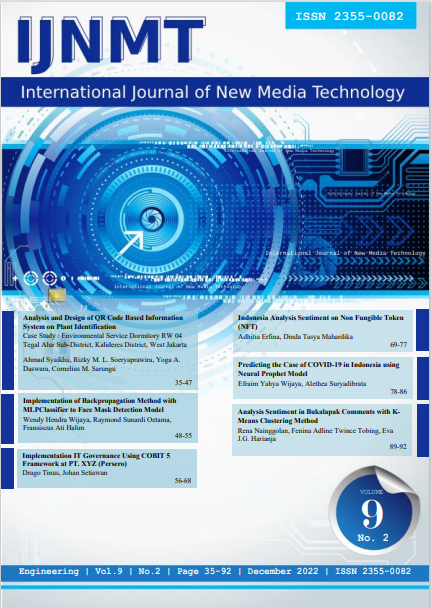Analysis and Design of QR Code Based Information System on Plant Identification
Case Study : Environmental Service Dormitory RW 04 Tegal Alur Sub-District, Kalideres District, West Jakarta
DOI:
https://doi.org/10.31937/ijnmt.v9i2.2570Abstract
At the location of the environmental service dormitory in RW 04 Tegal Alur sub-district, Kalideres district, West Jakarta, the community cultivate various types of plants and there is a requirement to introduce or educate the public about types of plants and their benefits. The purpose of this research project is to analyze the needs, as well as to design the QR Code-based information system, especially in the process of educating the types of plants and their benefits in the area. The design process uses the object-oriented analysis and design (OOAD) method which explores UML modelling (use case, activity diagram, sequence diagram, class diagram). The analysis will be carried out on to be implemented business processes, then the results of the analysis are poured into the design of a QR code-based information system in the form of web and mobile app that can assist educational activities. Web application will be used by the administrator to manage data to be displayed in mobile app. Mobile app will be used by the user to explore plant species and their benefits based on QR code that installed near the plants.
Downloads
Additional Files
Published
How to Cite
Issue
Section
License
Authors retain copyright and grant the journal right of first publication with the work simultaneously licensed under a Creative Commons Attribution-ShareAlike International License (CC-BY-SA 4.0) that allows others to share the work with an acknowledgement of the work's authorship and initial publication in this journal.
Authors are able to enter into separate, additional contractual arrangements for the non-exclusive distribution of the journal's published version of the work (e.g., post it to an institutional repository or publish it in a book), with an acknowledgement of its initial publication in this journal.
Copyright without Restrictions
The journal allows the author(s) to hold the copyright without restrictions and will retain publishing rights without restrictions.
The submitted papers are assumed to contain no proprietary material unprotected by patent or patent application; responsibility for technical content and for protection of proprietary material rests solely with the author(s) and their organizations and is not the responsibility of the IJNMT or its Editorial Staff. The main (first/corresponding) author is responsible for ensuring that the article has been seen and approved by all the other authors. It is the responsibility of the author to obtain all necessary copyright release permissions for the use of any copyrighted materials in the manuscript prior to the submission.















